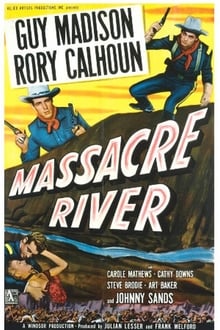
I'm a jinx Larry.
Massacre River is directed by John Rawlins and written by Louis Stevens. It stars Guy Madison, Rory Calhoun, Carole Matthews, Cathy Downs, Johnny Sands and Steve Brodie. Music is by John Leipold and Lucien Moraweck and cinematography by Jack Mackenzie.
Three army buddies, two ladies, and Indians unhappy about land encroachments. Spells trouble for sure.
Massacre River is a tricky Western to recommend in that it is not one for those expecting a Cavalry and Indians actioner, this is no high energy "B" Western. It relies heavily on character dynamics and a story ripe with surprising forays into darker territories. In fact it is far from routine stuff, a tag that even the New York Times reviewer of the time was quickly wrong to call it.
We have five people caught in a devil's pentagon, friendships and passions are tested and emotions reach boiling point. Thankfully the makers involved here have the courage of their convictions to make bold decisions with some of the characters. Decisions that bring the pic into a film noir realm, which when aided by some pleasing monochrome photography, and shadow play when the story goes bleaker, marks this out as very being aware of that style of film making that was bubbling away with menace at the time.
It begins all jaunty with pals larking around, even bordering on the homo erotic as two of the guys wrestle in a bath of water (seriously), and with a meeting of the fort colonel and the Indian chief (Art Baker and Iron Eyes Cody) outlaying a problem brewing between the two factions, it appears to be heading into "formula". But once the action switches to Jackson (the last outpost bordering Massacre River), the whole tone shifts, very much so, and it becomes a spicy hotbed of human agonies and vagaries of fate.
Problems exist of course. It's nice to have Calhoun and Brodie in the same movie, but the former's fans are made to wait for him to be seen at his best, while the latter is very under used. Story wise there is a hint of under staffing at one of the forts, but it's not explored for benefit, while the Indian angle ultimately feels tacked onto the human drama. But it's nicely performed by the cast, there's some nice photography and camera work, while the comforting sight to Western fans of the Iverson Ranch locale is boosted by shots filmed at Canyon de Chelly National Monument.
Well worth a look for Western fans familiar with noirish angles of the period. 7/10
Footnote: Some sources have it listed as being in Sepiatone. Not sure if it was filmed originally in that format? But the print I saw via TCM's HD channel wasn't so, it was a straight and very nice looking monochrome print.